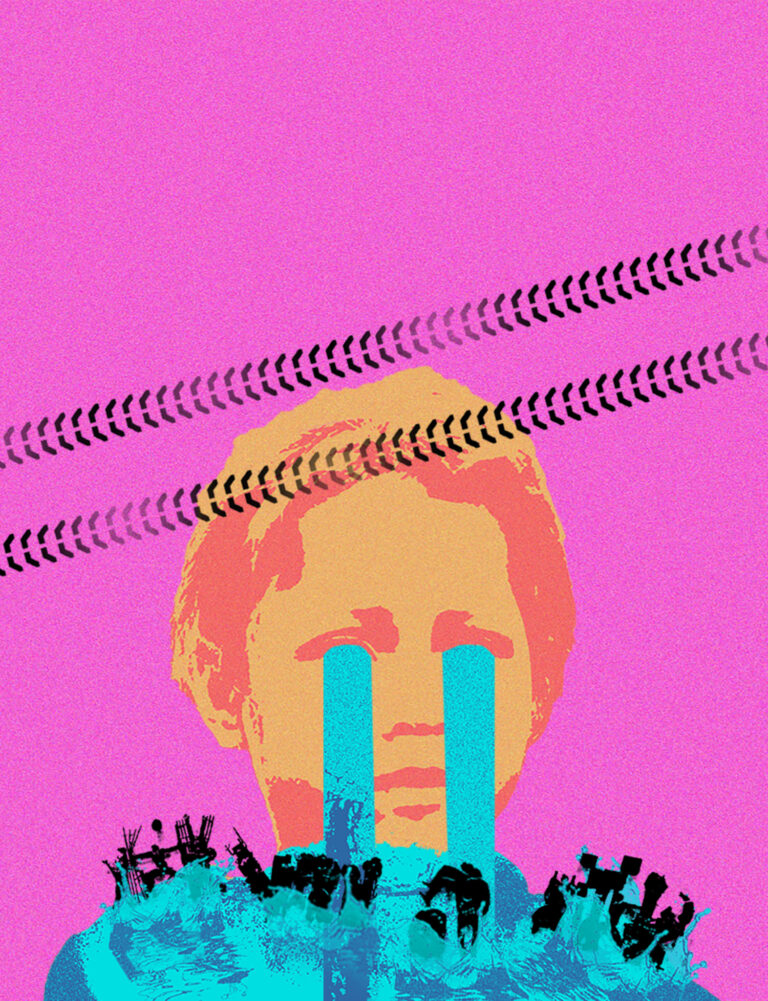The cover art for MER issue 306 is part of a collaboration with the independent Iraqi media initiative, Jummar. The image was designed by Atef Al Jaffal, an Iraqi visual artist based in Baghdad and Jummar’s graphic designer. The prompt was to design a cover that speaks to the issue’s theme: the state of Iraq 20 years on from the US invasion. What does this state evoke for the artist? Al Jaffal describes the symbolism behind the image he designed, “Iraq’s Crying Child.” His text, shared below, has been translated into English and edited, slightly, for clarity:
طفلة العراق الباكية تُمثّل المقهورين والمقهورات في المجتمع العراقي، الذين نالت الحروب والحصار الاقتصادي والفساد السياسي منهم. جسدها، بذلك، يُمثّل العراق جغرافياً ومعنوياً الذي تشقه دموعها، كما نهري دجلة والفرات، علها تعوض الجفاف الحاصل. أما القطع الغارقة في دموعها، فتلك هي المصبوبات البرونزية الأربع عشر التي تشكل “نصب الحرية” للفنان جواد سليم، وتُمثّل كل واحدة منها فرداً وتروي قصة ومرحلة. النصب الواقع في ساحة التحرير وسط بغداد منذ 1961، يرمز لحقب سياسية وثورات وأحداث مهمة في تاريخ العراق، وكان عرضة -أسوة بشخوصه- للأخطار والتهميش الذي لاقاه العراق على مدى الأعوام، وتحديداً بعد الغزو الأميركي عام 2003 ومع الغزو أيضاً طَبَعَتِ الدبابات الامريكية آثار عجلاتها على أراضي العراق، واستخدمت هذه العربات الثقيلة تحديداً لأنها تستطيع المرور على الوحل والطين والأرض الوعرة على حد سواء، بيد أنها كانت تدهس المدنيين والملكيات العامة في طريقها. آثار العجلات ما زالت محفورة في ذاكرة أجيال ما بعد 2003، كما في تصميم طفلة العراق الباكية

Cover Image for MER issue 306 designed by Atef Al Jaffal.
“Iraq’s Crying Child”
Iraq’s crying child symbolizes the oppressed in Iraqi society—those who have been affected by wars, sanctions and political corruption. Her body represents Iraq geographically and metaphorically. Her tears cut through it like the Tigris and Euphrates rivers. Perhaps they can make up for the country’s current drought.
Drowning in her tears are the fourteen bronze castings that comprise Baghdad’s iconic “Freedom Monument,” designed by the artist Jewad Selim (1919-1961). The monument was erected in 1961 in Tahrir Square in central Baghdad. It depicts the political eras, revolutions and significant events in the history of Iraq. Each individual casting narrates its own story and stage. Like its characters, the monument has been exposed to the dangers and marginalization that Iraq has faced over the years, particularly after the US invasion in 2003.
With the invasion, US tanks also left their tracks on the territory of Iraq. These heavy vehicles were used specifically because they are able to pass through dirt, mud and rough terrain alike. Yet, they also trampled over civilians and public property in their path. The tracks continue to be etched in the memory of generations after 2003 as they are in the design of Iraq’s crying child.
Read the first article in MER issue 306 “The State of Iraq–20 Years After the Invasion.”
